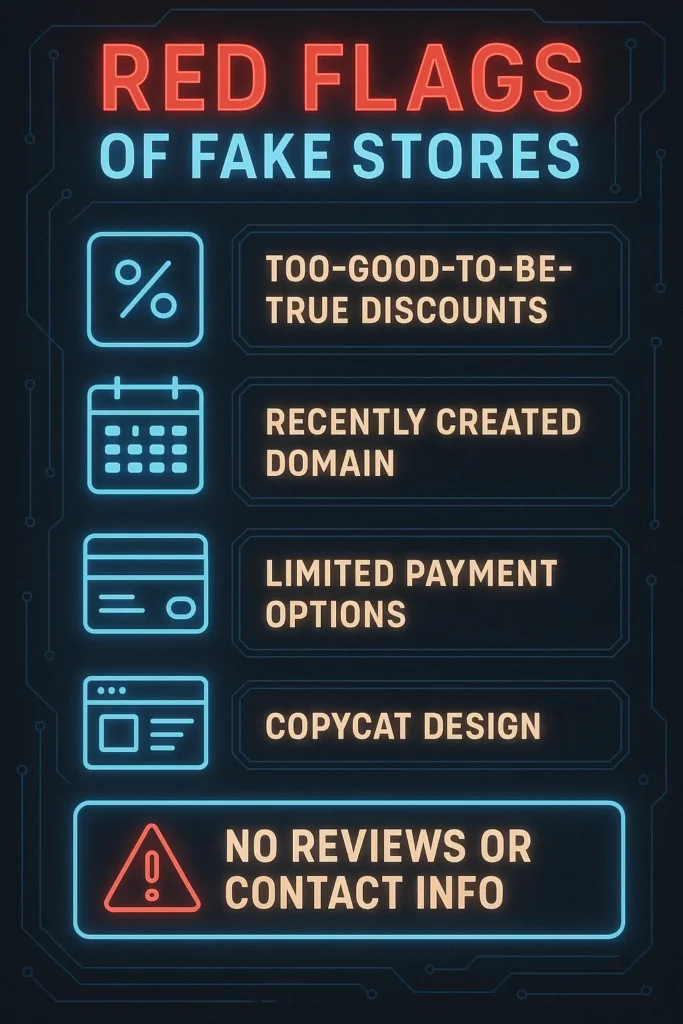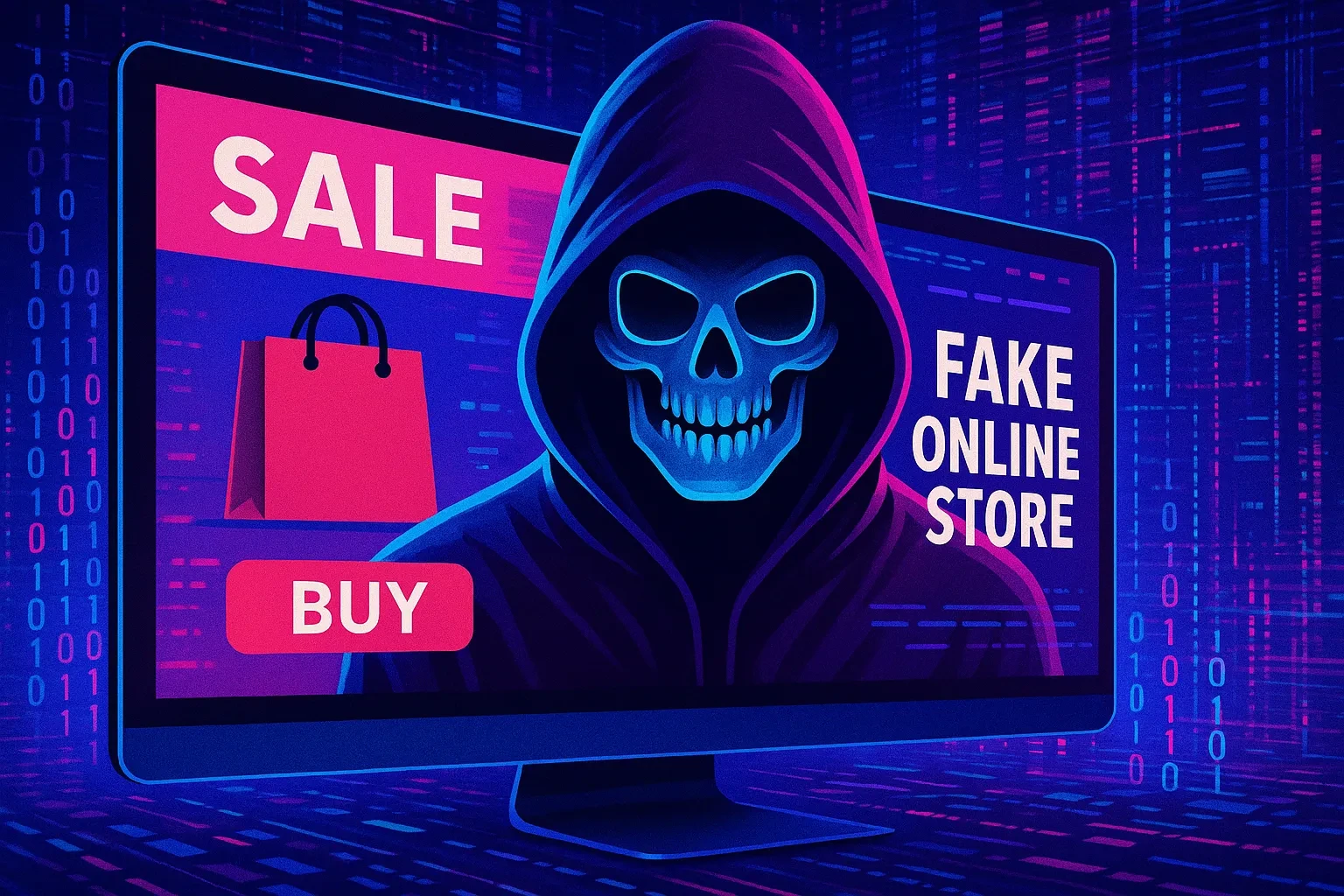By a cybersecurity journalist who investigates global e-commerce fraud networks
⚠️ Disclaimer
This article is for educational and ethical purposes only. It does not promote or support any form of fraud. Its sole goal is to help readers recognize and avoid online shopping scams by presenting real, verified cases and defense strategies.
🎬 Introduction
You Didn’t Buy a Jacket — You Bought a Trap
It looked like a deal — sleek Nike gear for 75% off. The store had an SSL lock, professional design, even reviews.
So you bought. And waited. And waited.
The tracking number? Fake.
The support email? Dead.
The website? Gone.
You didn’t just lose $89. You gave your payment data to organized fraud operations.
Welcome to the epidemic of fake online stores — an evolving ecosystem of deception fueled by social media, AI, and digital advertising. In 2025, they’re more convincing than ever.
Let’s take you inside the mechanics, cases, and countermeasures.
🧠 How Modern Fake Stores Work (2025 Edition)
| Phase | Tactic | Telltale Signs |
|---|---|---|
| Bait | Viral Instagram, Facebook, TikTok ads | Unreal discounts, countdown timers |
| Legitimacy Theater | SSL, fake logos, scraped product images | “Trusted Site” badges, cloned Shopify themes |
| The Hook | Urgency, checkout manipulations | “Only 2 left”, “Flash sale ends in 1:23” |
| Exit | Payment via crypto/debit/gift card | No refund path, no contact, domain shuts down |
Why it works:
- Low setup cost (free templates, AI-generated content)
- Paid traffic from Instagram, TikTok, Google
- Fast domain rotation: use, scam, abandon
- Global targeting, local deception
📂 Real Case 1: 123 Importados (Brazil, 2020)
Source: Wikipedia
In 2020, a website called 123 Importados swept through Brazil’s social media feeds, promising brand-name electronics at too-good-to-be-true prices. Smartphones, tablets, and Bluetooth speakers were listed with discounts of up to 70%. The store looked convincing: modern layout, slick branding, and plenty of fabricated customer reviews.
But what thousands of Brazilians didn’t know is that it was a meticulously orchestrated scam. The site accepted only boleto bancário — a local bank slip payment method that’s irreversible once processed. Victims paid and waited, but no orders were ever fulfilled.
Brazilian authorities launched a criminal investigation after more than 10,000 complaints surfaced. Eight individuals were arrested. The estimated losses exceeded $2 million USD. The case of 123 Importados became a national wake-up call: not every store with SSL and stock images is safe.
📂 Real Case 2: Ghost Stores (Australia, 2025)
Sources:
In 2025, the Australian Competition and Consumer Commission (ACCC) began tracking an alarming trend: dozens of online stores with elegant branding and local-sounding names — like “Everly Melbourne” and “Sophie Claire” — were pulling off near-perfect retail deceptions.
These so-called “ghost stores” claimed to be small boutiques, offering limited-time sales on fashion items. After checkout, customers received fake tracking numbers. The packages never arrived. What’s worse — payment processors often refused to refund because shipping data appeared valid.
With over 360 formal complaints submitted to the ACCC, regulators warned that these scams were specifically designed to look Australian, feel familiar, and avoid suspicion. Behind the scenes, the sites were operated from overseas using short-lived domains and template storefronts.
📂 Real Case 3: Fake BBQ Site Scam (Australia)
Source:
Not all scams are massive. Some are just as painful on a personal scale.
In a case documented by Scamwatch Australia, a couple ordered a discounted backyard grill from a slick-looking online store. The price: AU$160. Soon after paying, they received a professional-looking email: “Due to high demand and delivery congestion, your order is delayed.”
That was the last message they would ever get. The site disappeared days later. No product. No refund. And because they paid by direct bank transfer, there was no recourse.
This scam wasn’t complex — it didn’t need to be. It relied on trust, aesthetics, and a good deal. And it worked.
🛑 Visual Guide: Spotting a Fake Store
[ Ad on Instagram ]
|
V
[ Beautiful homepage with SSL lock ]
|
V
[ Unreal discount on Nike / Adidas / Tech ]
|
V
[ Checkout → Crypto / Debit Card only ]
|
V
[ Fake tracking / No delivery / Vanish ]
🧩 Psychological Tricks They Use
- Urgency: “Only 1 left in stock!”
- Social proof: Fake reviews with stock photos
- Trust indicators: SSL, badges (“McAfee Secure”)
- Mirrored UI: Using design themes identical to legit brands
- Language targeting: Using local language, currency, and regional domains (e.g.,
.uk,.de) for added realism
💡 How to Check If a Store Is Real
| Check | What to Do |
|---|---|
| Domain age | Use whois.domaintools.com or ICANN WHOIS |
| Business registration | Google the company name + “scam” or “reviews” |
| Payment methods | Avoid stores that don’t offer credit card or PayPal |
| Refund policy | Real stores have real terms, addresses, phone numbers |
| Suspicious URL | Watch for dashes, typos, or added words like “-sale” or “-official” |
💬 Quote from Law Enforcement
“Online store scams have exploded since 2020. These aren’t amateurs. They’re part of larger cybercrime ecosystems operating across jurisdictions.”
— James Layton, FTC Cybercrime Unit
🧠 If You’ve Been Scammed: Recovering Mentally, Financially, and Legally
Being scammed is more than just a financial loss. It can shake your trust in technology, brands, even yourself. Here’s how to recover:
💬 1. Don’t blame yourself
Scammers are professionals. They exploit psychological triggers, not gullibility. Falling for a fake store doesn’t mean you’re careless — it means you’re human.
🧾 2. File an official report
This isn’t just for statistics — reports help authorities map networks and take down fraud rings.
- United States: IC3.gov
- Australia: Scamwatch.gov.au
- Europe: econsumer.gov
- Global: Interpol Scam Reporting
⚖️ 3. Join a class-action or legal effort
If the scam affected many people, search online for a class-action suit. Forums like Reddit or local legal aid websites may offer paths to join collective efforts.
🔐 4. Secure your identity
If you gave away personal data — email, phone, address — consider:
- Setting up identity monitoring (e.g., Norton LifeLock, Credit Karma)
- Changing passwords on related accounts
- Watching for phishing emails that reference your original order
💡 5. Turn your experience into advocacy
Scammed once? Become the voice that warns ten others. Post about it, educate your friends and family, and help normalize talking about online fraud.
Quote to remember:
“Being scammed is not your shame. Silence is the scammer’s shield.”
- Contact your bank immediately
- Request a chargeback if paid via credit card
- Report the site to IC3.gov, Scamwatch, or local authorities
- Warn others via forums like Reddit or Trustpilot
- Enable credit monitoring if you shared financial info
✅ Safety Checklist: Online Shopping in 2025
| ✅ Step | Why |
|---|---|
| Use credit card or PayPal | Easier dispute resolution |
| Always Google the store name + “scam” | Scammers rarely last long unnoticed |
| Check domain age and WHOIS info | Real businesses aren’t born yesterday |
| Don’t trust countdowns or “Last 2 Left!” | It’s artificial urgency |
| Use browser safety extensions (WOT, Bitdefender TrafficLight) | Adds a second opinion to sketchy links |
| Avoid shopping from ads alone | Always access the store via known search or direct URL |

🧠 Glossary
- WHOIS – Tool to check domain registration (owner, date, server)
- Chargeback – Reversal of a card transaction after fraud
- Drop Domain – Domain used for short-term scam, then discarded
- Dark Ad – Ad shown to narrow, invisible audiences (used in scams)
❓FAQ
Q: I received a product, but it’s not what I ordered. Is that still a scam?
A: Yes — bait-and-switch tactics are commonly used to bypass disputes.
Q: Is shopping on Facebook or Instagram safe?
A: Only if you’re buying from verified pages or clicking to official brand sites. Most scam shops run paid ads through fake pages.
Q: Can scammers use PayPal too?
A: Sometimes. But most avoid PayPal due to buyer protections. If you must pay — use PayPal with buyer protection enabled.
🎯 Conclusion
In the end, fake online stores don’t just steal your money — they steal your trust in the internet itself. These scams are engineered not by lone hackers in dark basements, but by professional fraud networks exploiting design trends, psychological triggers, and platform loopholes.
It’s not about being naive — it’s about being human. The allure of a discount, the convenience of a one-click purchase, the trust in a polished web interface — these are not flaws. They’re features of how we shop in 2025. And that’s exactly what scammers weaponize.
The real defense? Awareness sharpened into instinct. A pause before purchase. A search before click. A refusal to believe that a deal too good to be true might somehow still be true.
You can’t shut down every scam site — but you can deny them what they need most: your click, your card, and your silence.
Because the most dangerous thing about fake stores isn’t the product you didn’t receive — it’s the lesson you didn’t learn.
